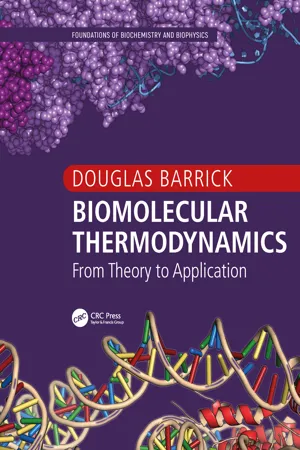
- 524 pages
- English
- ePUB (mobile friendly)
- Available on iOS & Android
About this book
"an impressive text that addresses a glaring gap in the teaching of physical chemistry, being specifically focused on biologically-relevant systems along with a practical focus…. the ample problems and tutorials throughout are much appreciated."
–Tobin R. Sosnick, Professor and Chair of Biochemistry and Molecular Biology, University of Chicago
"Presents both the concepts and equations associated with statistical thermodynamics in a unique way that is at visual, intuitive, and rigorous. This approach will greatly benefit students at all levels."
–Vijay S. Pande, Henry Dreyfus Professor of Chemistry, Stanford University
"a masterful tour de force…. Barrick's rigor and scholarship come through in every chapter."
–Rohit V. Pappu, Edwin H. Murty Professor of Engineering, Washington University in St. Louis
This book provides a comprehensive, contemporary introduction to developing a quantitative understanding of how biological macromolecules behave using classical and statistical thermodynamics. The author focuses on practical skills needed to apply the underlying equations in real life examples. The text develops mechanistic models, showing how they connect to thermodynamic observables, presenting simulations of thermodynamic behavior, and analyzing experimental data. The reader is presented with plenty of exercises and problems to facilitate hands-on learning through mathematical simulation.
Douglas E. Barrick is a professor in the Department of Biophysics at Johns Hopkins University. He earned his Ph.D. in biochemistry from Stanford University, and a Ph.D. in biophysics and structural biology from the University of Oregon.
Frequently asked questions
- Essential is ideal for learners and professionals who enjoy exploring a wide range of subjects. Access the Essential Library with 800,000+ trusted titles and best-sellers across business, personal growth, and the humanities. Includes unlimited reading time and Standard Read Aloud voice.
- Complete: Perfect for advanced learners and researchers needing full, unrestricted access. Unlock 1.4M+ books across hundreds of subjects, including academic and specialized titles. The Complete Plan also includes advanced features like Premium Read Aloud and Research Assistant.
Please note we cannot support devices running on iOS 13 and Android 7 or earlier. Learn more about using the app.
Information
| chapter 1 Probabilities and Statistics in Chemical and Biothermodynamics |
Table of contents
- Cover
- Half Title
- Title Page
- Copyright Page
- Dedication
- Contents
- Detailed Contents
- Series Preface
- Preface
- Acknowledgments
- Note to Instructors
- Author
- Chapter 1: Probabilities and Statistics in Chemical and Biothermodynamics
- Chapter 2: Mathematical Tools in Thermodynamics
- Chapter 3: The Framework of Thermodynamics and the First Law
- Chapter 4: The Second Law and Entropy
- Chapter 5: Free Energy as a Potential for the Laboratory and for Biology
- Chapter 6: Using Chemical Potentials to Describe Phase Transitions
- Chapter 7: The Concentration Dependence of Chemical Potential, Mixing, and Reactions
- Chapter 8: Conformational Equilibrium
- Chapter 9: Statistical Thermodynamics and the Ensemble Method
- Chapter 10: Ensembles That Interact with Their Surroundings
- Chapter 11: Partition Functions for Single Molecules and Chemical Reactions
- Chapter 12: The Helix–Coil Transition
- Chapter 13: Ligand Binding Equilibria from a Macroscopic Perspective
- Chapter 14: Ligand Binding Equilibria from a Microscopic Perspective
- Appendix: How to Use Mathematica
- Bibliography
- Index